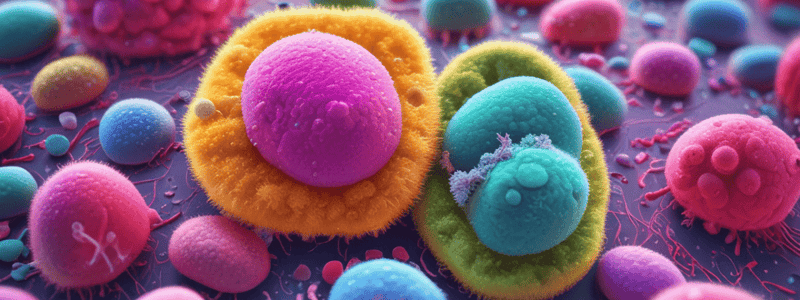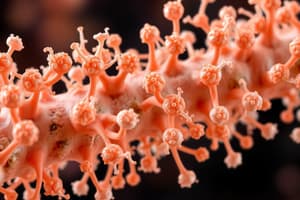Podcast
Questions and Answers
What method involves reducing microbial populations to safe levels by public health standards?
What method involves reducing microbial populations to safe levels by public health standards?
- Disinfection
- Sterilization
- Disinfectant
- Pasteurization (correct)
Which term refers to the complete destruction of all microbes, including cells, spores, and viruses?
Which term refers to the complete destruction of all microbes, including cells, spores, and viruses?
- Pasteurization
- Disinfection
- Sterilization (correct)
- Disinfectant
What is the term for chemical substances that eliminate pathogens on inanimate objects?
What is the term for chemical substances that eliminate pathogens on inanimate objects?
- Pasteurization
- Disinfection (correct)
- Sterilization
- Antiseptic
Which method involves the destruction or elimination of most pathogens from nonliving objects by physical or chemical methods?
Which method involves the destruction or elimination of most pathogens from nonliving objects by physical or chemical methods?
What term refers to solutions used to disinfect skin and other living tissues?
What term refers to solutions used to disinfect skin and other living tissues?
Which method involves the complete destruction of all microbes, including cells, spores, and viruses?
Which method involves the complete destruction of all microbes, including cells, spores, and viruses?
What is the purpose of the biological indicators used in autoclaving?
What is the purpose of the biological indicators used in autoclaving?
What is the primary reason for improper maintenance of the autoclave equipment?
What is the primary reason for improper maintenance of the autoclave equipment?
What is the primary purpose of loosening screw caps on bottles and tubes of liquids before autoclaving?
What is the primary purpose of loosening screw caps on bottles and tubes of liquids before autoclaving?
What is the primary reason for waiting 10 minutes after opening the autoclave door before removing liquids?
What is the primary reason for waiting 10 minutes after opening the autoclave door before removing liquids?
What is the primary purpose of wearing eye and face protection, as well as heat-resistant gloves, when operating an autoclave?
What is the primary purpose of wearing eye and face protection, as well as heat-resistant gloves, when operating an autoclave?
What is the primary reason for ensuring the autoclave has been properly serviced?
What is the primary reason for ensuring the autoclave has been properly serviced?
Which characteristic is NOT an ideal characteristic of antimicrobial agents?
Which characteristic is NOT an ideal characteristic of antimicrobial agents?
Which antibiotic is classified based on its mode of action as targeting the cell wall of bacteria?
Which antibiotic is classified based on its mode of action as targeting the cell wall of bacteria?
Which antibiotic originates from Penicillium molds?
Which antibiotic originates from Penicillium molds?
What is a commonality among Beta-lactam antibiotics?
What is a commonality among Beta-lactam antibiotics?
Which antibiotic group can be bacteriostatic or bactericidal depending on concentration?
Which antibiotic group can be bacteriostatic or bactericidal depending on concentration?
Which antibiotic group focuses on inhibiting protein synthesis in bacteria?
Which antibiotic group focuses on inhibiting protein synthesis in bacteria?
Which bacteria can easily spread in hospital settings and are resistant to Methicillin and Vancomycin?
Which bacteria can easily spread in hospital settings and are resistant to Methicillin and Vancomycin?
Which bacteria are the indigenous flora, but proliferate due to antibiotic treatment and cause hospital-associated diarrhea?
Which bacteria are the indigenous flora, but proliferate due to antibiotic treatment and cause hospital-associated diarrhea?
Which type of drug resistance in bacteria involves the acquisition of genes that destroy or inactivate drugs?
Which type of drug resistance in bacteria involves the acquisition of genes that destroy or inactivate drugs?
Which bacteria are members of the Enterobacteriaceae family and produce special types of beta-lactamases that inactivate Carbapenems?
Which bacteria are members of the Enterobacteriaceae family and produce special types of beta-lactamases that inactivate Carbapenems?
Which bacteria are resistant to two common drugs used to treat tuberculosis (Isoniazid and Rifampin), and some strains are resistant to almost all drugs?
Which bacteria are resistant to two common drugs used to treat tuberculosis (Isoniazid and Rifampin), and some strains are resistant to almost all drugs?
What is the most important strategy to combat drug resistance in bacteria, according to the text?
What is the most important strategy to combat drug resistance in bacteria, according to the text?
What is the primary factor that determines the effectiveness of heat for sterilization?
What is the primary factor that determines the effectiveness of heat for sterilization?
Which of the following is NOT a form of heat sterilization mentioned in the text?
Which of the following is NOT a form of heat sterilization mentioned in the text?
What is the typical pressure and temperature used in an autoclave for sterilization?
What is the typical pressure and temperature used in an autoclave for sterilization?
Which of the following types of microorganisms can be effectively destroyed by autoclaving at the specified conditions?
Which of the following types of microorganisms can be effectively destroyed by autoclaving at the specified conditions?
What is the purpose of quality control (QC) in the autoclaving process?
What is the purpose of quality control (QC) in the autoclaving process?
Which of the following is NOT mentioned as a method of quality control for autoclaving?
Which of the following is NOT mentioned as a method of quality control for autoclaving?
Flashcards are hidden until you start studying
Study Notes
Methods of Microbial Control in Vitro
- Microbial control involves methods of inhibiting microbial growth, inhibition, and destruction
- Methods of microbial control can be categorized into physical, chemical, and biological methods
Sterilization, Disinfection, and Antiseptics
- Sterilization: the complete destruction of all microbes, including cells, spores, and viruses
- Disinfection: the destruction or elimination of most pathogens from nonliving objects by physical or chemical methods
- Antiseptics: chemical substances used to disinfect skin and other living tissues
- Pasteurization: a method of reducing microbial populations to levels considered safe by public health standards
Heat Sterilization
- Heat is a practical, efficient, and inexpensive method of sterilization for inanimate objects
- Two factors determine the effectiveness of heat for sterilization: temperature and time
- Thermal death point (TDP) is the lowest temperature that will kill all organisms in a standardized pure culture within a specified time
- Dry heat: uses flame and incineration; moist heat: uses autoclave
Autoclave
- Autoclave is a common method of sterilization used in places where sterile items are required, such as tattoo parlors, microbiology labs, and medical facilities
- Autoclave uses pressure and steam to sterilize items, with typical specifications of 15 psi, 121°C, and 15-20 minutes
- Autoclaving destroys vegetative microorganisms, bacterial endospores, and viruses
- Quality control is essential to ensure that items are properly sterilized
Autoclave Quality Control
- Chemical indicators: temperature-sensitive tapes or bags
- Physical indicators: alloys that melt when exposed to correct temperature for at least 15 minutes
- Biological indicators: sealed ampules with heat-resistant bacteria
Common Faults in Autoclave Operation
- Inadequate precleaning of instruments
- Improper maintenance of equipment
- Cycle time too short or temperature too low
- Overloading or improper loading of sterilizer chamber
- Incompatible packaging material
- Interruption of sterilization cycle to add or remove an item
- Wrong cycle was selected
- Mechanical failure or insufficient water supply
Autoclave Safety
- Loosen screw caps on bottles and tubes of liquids before autoclaving
- Always check that chamber pressure has returned to zero before opening door
- Wear eye and face protection and heat-resistant gloves
- Stand behind door when opening it
- Slowly open door only a crack to allow residual steam to escape
Physical Methods of Inhibition
- Cold can have a static effect, halting growth
- Some methods preserve, such as penicillin produced by Penicillium mold
Antibiotics
- Ideal characteristics of antimicrobial agents:
- Kills or inhibits growth of target pathogen
- Causes no damage to host
- No allergic reaction in the host
- Stable when stored in solid or liquid form
- Penetrates and remains in target tissue
- No resistance
- Antibacterial agents can be organized by mode of action:
- Cell wall: beta-lactams
- Protein synthesis: glycopeptides
- Genetic material: quinolones
- Cell membrane: polymyxins
- Metabolic process: sulfonamides and trimethoprim
Beta-Lactam Antibiotics
- Commonalities: beta-lactam ring, target cell wall, and are bactericidal
- Differences: side groups, specificity, and spectrum
- Examples: penicillin, cephalosporin, and carbapenems
Mechanisms of Drug Resistance
- Intrinsic resistance
- Mutations:
- Chromosomal mutation that alters drug-binding site
- Chromosomal mutation that causes a change in cell membrane permeability
- Acquisition:
- Of resistance genes that destroy or inactivate drugs
- Of genes that pump antimicrobials outside the cell
Strategies to Combat Drug Resistance
- Education
Studying That Suits You
Use AI to generate personalized quizzes and flashcards to suit your learning preferences.




